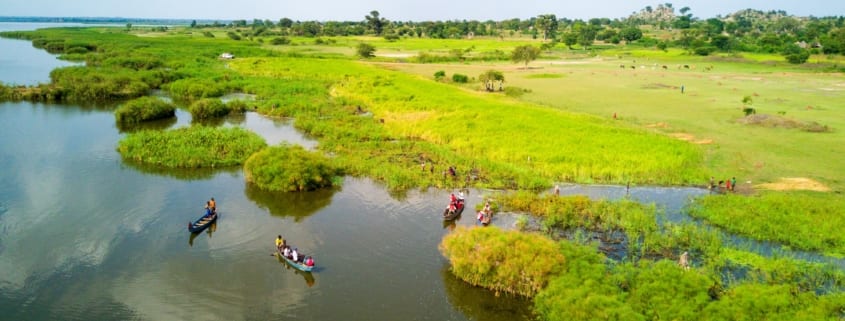Voices from the Rainforest: Esther Kagoya, Conservation Fellow
Rainforest Trust projects thrive thanks to the important conservation work of people on the ground. Our Voices from the Rainforest series brings you news from our projects in Latin America, Africa, Asia and the Pacific — from the perspectives of those working in and for the rainforests.

Educating Communities in Conservation
Esther Kagoya is a Ugandan conservationist with over five years of experience in natural resources and freshwater fisheries research. She holds a Masters in Fisheries Science from Pukyong National University in South Korea. Currently, Esther is working as a research scientist for Uganda’s National Fisheries Resource Research Institute (NaFIRRI) in fish stock assessment, capture fisheries management and biodiversity conservation.
She worked as a field officer during the Safeguarding a Global Freshwater Fish Hotspot project. A collaboration between Rainforest Trust, NaFIRRI and local stakeholders that safeguarded 10,448 acres on Lake Nyaguo with two fishing exclusion zones and a wetland buffer around the whole lake.

Esther (Bottom Right) with other Rainforest Trust Conservation Fellows and community members.
Why did you become a conservationist?
A combination of my education and field experience have inspired me to become a conservationist. I chose to earn my bachelor’s degree in Natural Resource Economics because of my passion for natural resource related issues. I am primarily interested in sustainable management and conservation. I conducted research for my final BSc project on the effects of fisheries policies on fish production and conservation.
In the final months of school, I worked as an intern with NaFIRRI. During this time I was able to further my knowledge of fisheries conservation and obtain the necessary hands-on skills for field work. Eventually, I became a research assistant for NaFIRRI where I work on biodiversity conservation programs.
“The program provides easy access to conservation education and funding opportunities. Plus, reading about the successful protection projects conducted by other Fellows on the Rainforest Trust website inspire me and make me proud to be a part of the Conservation Fellows.”
Tell us about a time that you felt you had made a difference as a conservationist?
Being a young conservationist, I am always involved and interested in managing natural resources for the betterment of the future. During my work on the Lake Nyaguo project, I truly felt that I made a difference in the community. Before Rainforest Trust’s involvement in the project, the site was characterized by cultivated and cleared catchment and vegetation, use of illegal fishing gears and methods, low catch rates and declining fish stocks. I was able to get involved in several parts of the project. I worked with the research and project teams to identify several drivers of resource and species degradation. I also had the opportunity to communicate directly with resource stakeholders through community consultative meetings.
After the project’s inception, the stakeholders and communities are now more aware of the benefits of conservation through change in resource use behavior. This gave them strength to sensitize other community members who were still using illegal fishing gears. The majority surrendered their destructive fishing gears and have transformed their use of destructive resource into practicing healthier ones. In addition, the project in collaboration with the local government enforced the wetland rules and regulations
Tell us about a conservation challenge in your job.
The main challenge I am currently facing is the lack of political interest in conservation. While riparian communities are willing to abide by the best practices of fishing using the stipulated laws, regulations and policies, politicians are communicating contrary messaging by encouraging people to utilize natural resources at their will. The convoluted messaging has made it difficult for resource use communities, specifically fishermen, who try to abide by the positive conservation practices. They are often misled by their politicians to use the equipment and methods that have a harmful effect.
Poverty among resource users is another challenge. Communities always look for short term gains without being mindful of the long term issues. This is mainly attributed to the high poverty levels in these communities and luck of alternative sources of livelihoods.
What is the hardest part of your job?
Conservation is a process that involves change in the mindset of resource users and other key stakeholders of the resource in question. However, this can be arduous because people are more interested in short-term resources and project gains like increasing resource productivity rather than the long-term gains of conservation.
Engaging communities in behavior change communication for long-term sustainability is quite challenging given that their mindset is fixed on short term gains. However, I believe that this is a gradual process that requires patience and in-depth understanding of the stakeholders and their interests. It is only a matter of time.
Header image: The Lake Nyaguo project site. Photo by Isabirye Aggrey.




